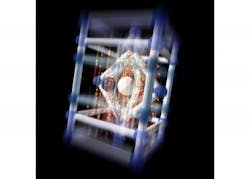Menlo Park, CA--At the SLAC National Accelerator Laboratory, scientists have taken x-ray images of a certain ferroelectric material (lead titanate, or PbTiO3) to show how it is able to exhibit photovoltaic (PV) properties.1 The approach gives researchers a tool to refashion the material so that it is more suitable for PV applications.
Some ferroelectric materials (materials that possess a stable electrical polarization switchable by an external electric field) are also photovoltaic, but it was traditionally not clear how photons induced voltages in these materials. But SLAC scientists have now determined first-hand what is going on: the dimension of the material's unit cell contracts in response to intense light and then rebounds to a dimension larger than the initial dimension. The process, which takes about 10 ps, indicates the mechanisms responsible for the material's photovoltaic effect. “What we saw was unanticipated,” Aaron Lindenberg says. “It was amazing to see such dramatic structural changes, which we showed were caused by light-induced electrical currents in the ferroelectric material.”
One-two punch: visible light and x-rays
The time-resolved x-ray scattering images were taken at the x-ray Pump Probe instrument of SLAC’s Linac Coherent Light Source (LCLS), which hit the ferroelectric samples with a "one-two" punch of 40 fs short-wavelength visible laser pulses and 60 fs x-ray pulses. The researchers analyzed information from thousands of images to determine the PV mechanism.
The fact that ferroelectric materials produce much higher voltages than conventional silicon-based materials makes them an attractive option for making PV cells, Lindenberg says. However, their very low light-conversion efficiency has precluded commercial applications. Now that researchers understand the underlying mechanism they can more effectively create ferroelectric materials that are more suitable for PV applications.
REFERENCE:
1. Dan Daranciang et al., Physical Review Letters, 23 February 2012; doi: 10.1103/PhysRevLett.108.087601

